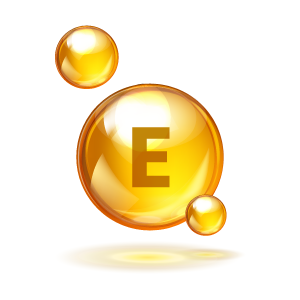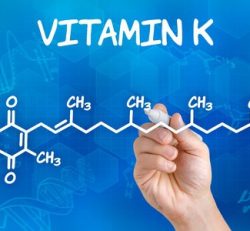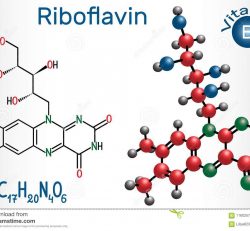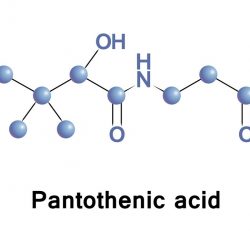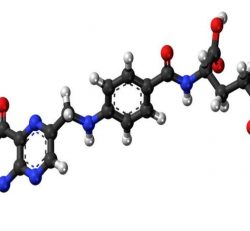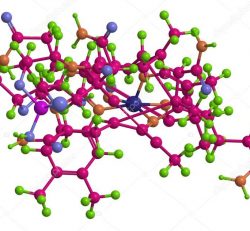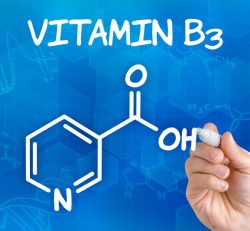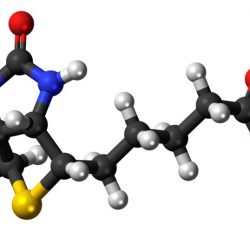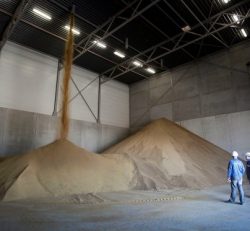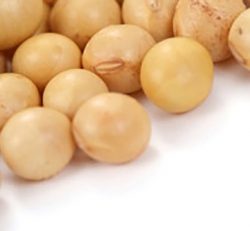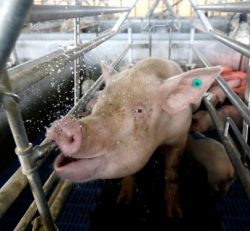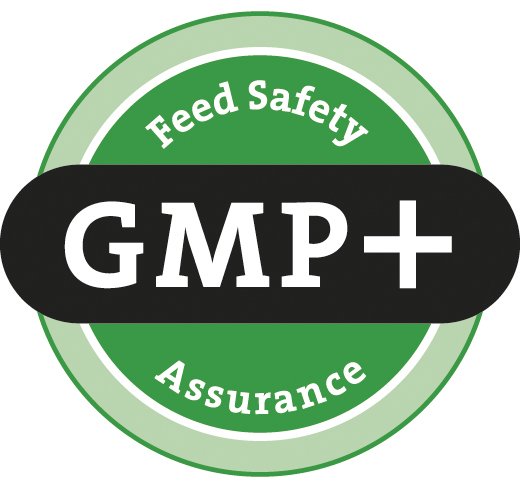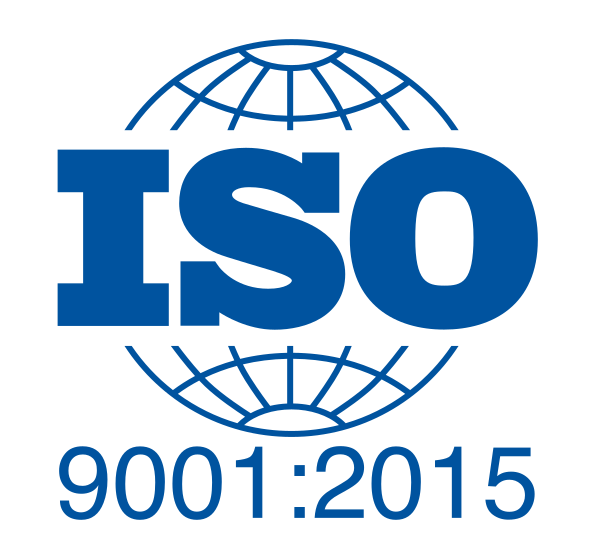VITAMIN E /SELENIUM
During the past few years problems associated with either the lack of availability of vitamin E and selenium, or absolute deficiencies have become major problems on some farms. These have arisen with the practice of using polyunsaturated fats in diets as sources of energy. The actual principles of vitamin E are called tocopherols and they are widespread in feed stuffs including vegetable oils, cereals and green plants.
Tocopherols are used in pig rations as dl-alpha-tocopherol acetate and measured in international units. The international unit (iu)1iu of vitamin E is defined as 1mg of a standard preparation of a specific tocopherol acetate.
Vitamin E is necessary for the optimum function and metabolism of the nervous, muscular, circulatory and immune systems, and the latter highlights its importance in maintaining the health of the pig.
Its function is basically to prevent the breakdown of oxygen at a cellular level (oxidation) when toxic products including hydrogen peroxide and hydroxyl radicals are produced. These oxidising agents are powerful tissue poisons.
The function of vitamin E in the pig
- To increase the efficiency of the immune system. Adequate levels must be available at critical times particularly as maternal antibody is dropping and pigs are being challenged by infectious agents. This highlights the importance of both diet quality and levels of energy lysine and vitamin E at these times.
- It acts as a tissue antioxidant. Heart muscle is particularly sensitive to oxidising agents, the reason why mulberry heart disease is so common.
- It helps to maintain the integral structure of muscles in the digestive and reproductive systems.
- It is involved in the synthesis of certain amino acids and vitamin C.
- It has a close relationship with selenium metabolism.
Selenium is an essential nutrient in its own right and part of an enzyme called glutathione peroxidase which also acts as a antioxidant and thus has a complementary role to vitamin E. The less selenium in the diet the greater is the requirement for vitamin E.
The recommended requirements to give a maximum boost to the immune system range from 75-220iu/kg. According to age of the pig and diet; this is in the first stage creep 220, the second stage 150, the grower 100, the finisher 60 and sow 50 iu/kg. These levels are probably higher than those necessary for maximum growth, which may be 50% less.
Polyunsaturated fatty acids PUFA’s cause considerable oxidation at tissue levels and when added to diets 3iu of vitamin E should be added for each g of PUFA.
Vitamin E and selenium related diseases
- Gastric ulcers – These are often stress oriented and the incidence increases where vitamin E levels are low.
- Hepatosis dietetica (HD) – A condition where there is necrosis or death of liver cells.
- Muscular or nutritional dystrophy (MD) (also called a myopathy) – This results from a degeneration of muscle fibres whether they be skeletal smooth or cardiac. Oedema or fluid is often produced around the tissues and muscles (PSE) as a result.
- Mulberry heart disease (MHD) (also called a myopathy)- A specific disease of heart muscle and a common cause of sudden death.
- Reproduction disorders – Vitamin E is involved in sperm production and ovarian function. The actual role of vitamin E on the farm is difficult to clarify.
Clinical signs
These vary according to the system affected. HD, MD and MHD are usually associated with sudden deaths in rapid growing pigs without any prior clinical signs, usually the best pigs in the pen are affected and they range from 15-30kg in weight. Diets being fed often contain high levels of fats and yet in many cases vitamin E levels appear within normal ranges. Post-mortem symptoms are characteristic and include:
- Large amounts of fluid around the heart and lungs.
- Haemorrhagic and pale areas in heart muscle.
- Fluid in the abdomen with pieces of fibrin.
- Pale muscle areas (necrosis) particularly in the lumber muscles and hind muscles of the leg which contain excesses amounts of fluid.
- If the liver is involved it is enlarged and mottled with areas of haemorrhage interspersed with pale areas.
Diagnosis
Histological examinations of the liver, heart or skeletal muscle will confirm diagnosis and this is the most accurate method. Serum samples should be taken from pigs at risk and tested for levels of vitamin E. Normal levels are variable from pig to pig however they should be more than 1.8mg/litre. The availability of selenium can be assessed by measuring the levels of glutathione peroxidase in the serum. If levels are less than 0.025µg/ml or 0.1mg/kg in liver a deficiency should be suspected and rations checked.
If MD is the major change stiffness and muscle trembling may be seen. If back muscle necrosis is involved sudden acute lameness occurs, particularly in gilts, especially outdoors, when they are moved into paddocks for the first time. This sudden exercise precipitates disease in association with the porcine stress syndrome (PSS).
Stress related problems include gastric ulcers and where lesions occur in more than 20% of pigs at slaughter, the addition of 50iu/kg of vitamin E should be assessed.
The role of vitamin E and selenium in reproductive performance is more difficult to quantify. Improvements have been noted in herds with persistent cases of agalactia and udder oedema by raising the levels in the lactating diet to 100iu/kg.
Similar diseases
These include:
- Actinobacillus pleuropneumonia.
- Glässers disease.
- Oedema disease.
- Streptococcal septicaemias.
Specific diseases associated with deficiencies of, or lack of availability include:
- Actinobacillus pleuropneumonia.
- E. coli diarrhoea.
- Oedema disease.
- Post-weaning respiratory syndrome.
- PRRS.
- Swine dysentery.
- and those diseases that occur during periods of immuno-suppression.
Treatment
- Where a population is at risk inject all the pigs with vitamin E/selenium e.g. dystocel, 70iu vitamin E and 1.5mg per 50kg is adequate, but seek veterinary advice.
- Sudden death in piglets following iron injection. Inject sows 14 days prior to farrowing with vitamin E/selenium.
- Water soluble preparations are sometimes available as alternatives.
- Multi-vitamins that include vitamin E and or selenium may be used. Refer to the recommended treatment levels on the bottle label.
- Move individual pigs to hospital pens for treatment.
- Increase vitamin E levels in creep and growing rations by 100-150iu/kg.
Management control and prevention
- If problems persist change to another diet with less added fats.
- Check the levels of PUFA’s in the diet.
- Check the levels of vitamin E and selenium.
- Check the levels of vitamin A. If more than 10,000iu/kg this may be increasing the requirement for vitamin E.
- Rapid growth may be a contributing factor.
- Reduce stocking densities if pigs are over crowded.
- Check there are no parasite burdens.
- Grains stored with high moisture content in high temperatures and with fungal growth may have low levels of vitamin E.
- Do not breed from animals that carry the stress gene.
Source: The Pig Site

